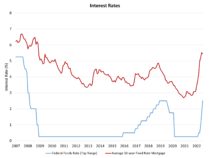Continuing its tightening of financial conditions to bring the rate of inflation lower, the Federal Reserve’s monetary policy committee raised the federal funds target rate by 75 basis points, increasing that target to an upper bound of 2.5%. This move matches the June rate hike as the largest increase for the funds rate since 1994.
While committing to a policy path that will slow demand and reduce inflation pressure, the Fed also, in the first sentence of its July policy statement, acknowledged signs of slowing economic activity (“Recent indicators of spending and production have softened.”).
Among the clear signs of this slowing are just about every housing indicator, including seven straight months of declines for home builder sentiment. Indeed, an open macro question is whether the economy experienced a recession during the first half of 2022. GDP data for the second quarter published tomorrow will provide additional evidence (although a rising unemployment rate remains missing for the NBER call). However, given declines for single-family permits, single-family starts, pending home sales, and rising sales cancellations rates, it is clear a housing industry recession is ongoing.
Market participants have reduced their expectations for future Fed rate hikes, which is perhaps a sign of renewed confidence in the ability of the Fed to bring inflation down (even if it means a recession in the so-called hard landing scenario). Higher interest rates and lower economic growth will eventually bring inflation rates down. The path of required additional tightening will depend on economic growth and inflation data, moving the Fed to a more data dependent stance. Thus, the chance of the Fed decelerating to a 50 basis point hike in September is increasing.

It is important to note that there is not a direct connection between federal fund rate hikes and changes in long-term interest rates. During the last tightening cycle, the federal funds target rate increased from November 2015 (with a top rate of just 0.25%) to November 2018 (2.5%), a 225 basis point expansion. However, during this time mortgage interest rates increased by a proportionately smaller amount, rising from approximately 3.9% to just under 4.9%.
Moreover, the spread between the 30-year fixed rate mortgage and the 10-year Treasury rate has expanded to more than 270 basis points as of this week. Before 2020, this spread averaged a little more than 170 basis points. This elevated spread is a function of MBS bond sales as well as uncertainty related to housing market uncertainty. While the 10-year rate has flattened in recent weeks on growth concerns, a reduction in this spread would be a positive sign for mortgage rates and housing demand.
Finally, the Fed has previously noted that inflation is elevated due to “supply and demand imbalances related to the pandemic, higher energy prices, and broader price pressures.” While this verbiage may incorporate policy failures that have affected aggregate supply and demand, the Fed should explicitly acknowledge the role fiscal, trade and regulatory policy is having on the economy and inflation as well.
Discover more from Eye On Housing
Subscribe to get the latest posts sent to your email.

